Caravaggio and the Physiology of Schizophrenia
by
Ronnie Mather
December 5, 2007
Caravaggio has long enjoyed a reputation as an anti-social and tempestuous individual. The following argues that Caravaggio was in fact suffering from paranoid schizophrenia. Following Wilhelm Reich’s argument that schizophrenic symptoms and delusions are the result of the projection of objective physiological processes occurring in discrete organs of the body, or at least body-systems, it interprets the changing nature of Caravaggio’s paintings as reflecting his own suffering in the eyes and throat. The latter’s predilection toward violence, and the portrayal of violence, is also interpreted in this light. It is argued that this accounts for his obsession with decapitation and raises the question about whether the revolution he initiated in painting around 1600 was itself the result of his coping with the illness.
“It is very difficult to formulate in words an experience in which a process in the organism is perceived and yet is not perceived as one’s own. But there can be no doubt whatsoever that this is exactly the key to understanding the schizophrenic split and the projection of bodily sensations” (Wilhelm Reich, 1945)
Michelangelo Merisi da Caravaggio was born in the town from which he derived his name in 1571 and died in 1610. He is without doubt one of the most debated figures in the history of art and has enjoyed a controversial reputation both contemporary and posthumous. A very violent individual, he has been viewed as simply a product of his times or as enduring “borderline personality disorder” (Chessick, 2000: 2067). His physical attacks on individuals ranged from inflicting death during a duel to cowardly attacks from behind in the dark. The duel, with one Ranuccio Tomassoni in 1606 in Rome, has been recorded as a homicide. In the legal sense, it was. The Council of Trent had forbidden duels. But Tomassoni enjoyed a formidable reputation as a swordsman, and came from a family with a considerable reputation for both military, and paramilitary, violence. He was not a man to be crossed lightly. Nevertheless, Caravaggio’s biographers record a host of serious attacks on unarmed individuals perpetrated in obvious fits of rage. Friedlander (1955: 233), quoting an early source, refers to an earlier killing in 1591 or 1592. Precise details are vague but Caravaggio was in serious trouble with the law in Milan and that may have motivated his move to Rome in 1592. He was a man with a clear predilection towards violence, fuelled, in part, by prolonged drinking sessions. Violence, alcohol, a propensity to dress in rags - “once he put on a suit of clothes he changed only when it fell into rags” (Langdon, 1999: 136) strangely at odds with his extreme grandiosity. In addition, his culinary habits are more grotesque than any of his severed heads. And that, by and large, is all that his biographers can agree on as being anywhere definitive of his character. His rap sheet in addition to murder is second to none. Caravaggio has become known as a homosexual painter in the English-speaking world but the evidence for this amounts only to a contentious reading of some of the males figures in his still life paintings of the early 1590s (for example, Boy with a Basket of Fruit, 1594). Hibbard (1983) who is often ascribed this position actually states “whether Caravaggio was essentially or exclusively homosexual is far from certain” (87). Gilbert (1995) demonstrates that the historical evidence for this is very close to non-existent. There has clearly been a propensity to fill in the gaps given that the historical record is so flimsy.
However, what is also clear is that Caravaggio’s contemporaries did find his attitude and behavior strange in the extreme. This is not simply a “violent man for violent times” scenario and his biographers sometimes fall into the trap of quoting evidence from these contemporaries while emphasizing the social milieu in which he moved (for example, Langdon, 1999). All or most of what they tell us can be summed up by the following, one of the central criterion of schizophrenia, “…difficulties in performing activities of daily living such as preparing a meal or maintaining hygiene. The person may appear markedly disheveled, may dress in an unusual manner…....unpredictable and untriggered agitation” (DSM,IV:300). It seems to us fairly likely that Caravaggio was suffering from the paranoid subtype of schizophrenia and that increasingly his search for self-understanding came to be reflected in his art. Following Hibbard (1983:65), we would place this change around 1599 with Judith Beheading Holofernes. That this is Caravaggio’s own fantasy, rather than a depiction of a biblical event is witnessed by the fact that Judith has the demeanor and the countenance of an ideologically committed vegetarian being compelled to slice roast beef (very rare). The horror is all to the left, Judith is an afterthought, or, to be more accurate, an excuse.
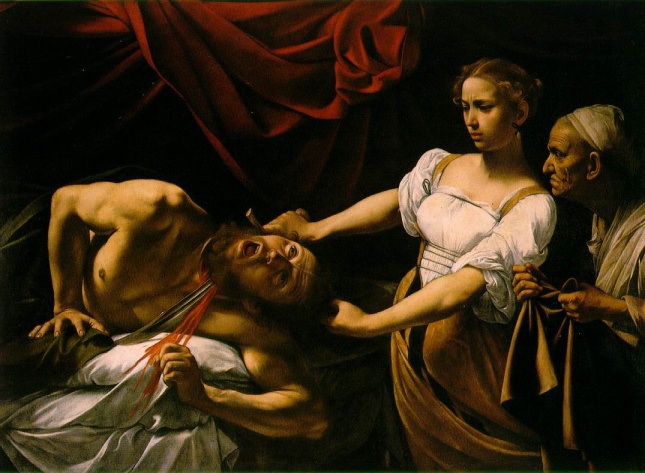
Caravaggio’s schizophrenia probably began to emerge in his late teens or early twenties, and may account for his trouble with the law in Milan at age 20 or 21. But it does not erupt into his art, and himself fully, until the above (or, arguably, the Head of the Medusa) painted the year before, at age 26 or 27 (paranoid schizophrenia often has a later onset than the other subtypes). Decapitation, in the classical Freudian sense, is indicative of a fear of castration, and Caravaggio duly obliges, adorning the neck with snakes. However, it is the nature and degree of violence in Caravggio’s own art that is perhaps most decisive in understanding the nature of his condition.
The relationship between untreated schizophrenia and violence is now well-established in the literature (Jayal et al, 2007; Schanda, 2004). Severe problems also exist in relation to treatment resistant schizophrenia and non-institutional compliance with taking antipsychotic medication (Valenstein et al, 2004) The exact origin of schizophrenia is unknown at this time but it is now accepted that it does involve at the very least a significant genetic component.—“Delusions are typically persecutory or grandiose, or both…features include anxiety, anger, aloofness, and argumentativeness…a superior and patronizing manner and either a stilted, formal quality or extreme intensity in interpersonal interactions. The persecutory themes may predispose the individual to suicidal behavior, and the combination of persecutory and grandiose delusions with anger may predispose the individual to violence” (DSM, IV, 313-14). A review of eight major studies conducted in the US concluded that five to ten per cent of schizophrenics commit acts of serious violence per year. The same study concluded that schizophrenics account for about ten per cent of all homicides in Europe (Torrey, 2006). The figure in the US is likely to be half that given the greater degree of institutionalization and therefore the taking of appropriate medication. It has been estimated that up to half of all schizophrenics have co-morbid substance abuse. This is constantly highlighted in the literature as dramatically increasing the risk of violence (Dixon, 1999). Such abuse usually leads to another common factor in the existing literature, “social drift”, schizophrenics enduring squalid living conditions and poor personal hygiene (Tilman et al, 1998). Social dislocation, is often an environmental risk factor in the onset or aggravation of the illness, a fact confirmed by the most recent survey of this area (Selten et al, 2007). And city-states in Caravaggio’s times were in fact, more akin to “countries” in their own right. Caravaggio’s biographers have provided some evidence of all of the above and usually all together. But it is Caravaggio’s art that might provide the best evidence of his malady. Wilhelm Reich, in his unjustly neglected writing, “The Schizophrenic Split” (published in 1945, as chapter 15 of Character Analysis) noted the centrality of both the throat and the eyes in the schizophrenic experience, and, quite crucially, the role that they play in schizophrenic self-harm and harm to others
“I suddenly understood with perfect clarity why and in what emotional situations murders are committed by schizophrenics…when the tension in the organs, especially in the diaphragmatic region and in the throat, becomes unbearably strong, the urge appears to cut one’s own stomach or throat…The murder occurs when the impulse is directed away from oneself towards something else” (Reich, 1945: 423-24).
Reich had a radical biophysical understanding of schizophrenia quite in line with the general tenor of that of today. The schizophrenic “perceives his body energy in a psychotically distorted manner” (Reich, 1945: 433). Reich speculated that the schizophrenic describes objective physiological processes that become completely divorced from the experience of self-perception and so are felt as something alien – the description by the sufferer of the illness itself, so often dismissed, is often a perfectly lucid description of the dissociation experienced. This accounts for the somatic and persecutory delusions of schizophrenia, somatic hallucinations featuring bodily functions that have literally taken on a life of their own, becoming terrified of their own bodily sensations that are then experienced as radically other. The schizophrenic experiences single organs, or systems, as radically discrete—“I suggest especially the brain” (Reich, 1945: 464). It is the physiology of the brain, with all its rushing intensity and activity, that the schizophrenic encounters, not the chastened and compliant arena that we call “mind”. However, Reich also speculated that the schizophrenic would experience such intensity in both the throat and the eye. Under such circumstances, which Reich rather vaguely describes as a “choking sensation”, schizophrenics might attack either themselves or others – “One day I let him turn his eyeballs upward again….he stared into one corner of the room, ripped his eyelids wide open, began to scream, and pointed in terror toward the corner…its right there, coming out of the wall, staring at me” (Reich, 1945: 472). Reich’s “cure”, that alleviation of the symptoms might be gained, through “body work” and the releasing of walled energy streams (“armoring”) is of course controversial and might be dismissed. But his analysis is worthy of close examination and the linkage between the tracking of the eyes and schizophrenia has been confirmed by later researchers in the field. Reich’s analysis also mentions one other area of the body in which such a dynamic might be perceived – the genital region (Reich, 1945: 468). Schizophrenics will direct assaults to those areas of the body in others that they perceive as having independent dynamic force in their own bodies. These invoke a clear sense of terror that Reich documents in detail.
Caravaggio painted his two versions of the conversion of Saint Paul sometime in 1600-01. The first painting is now in the Odescalchi Collection in Rome, after being rejected by its commissioning patron:
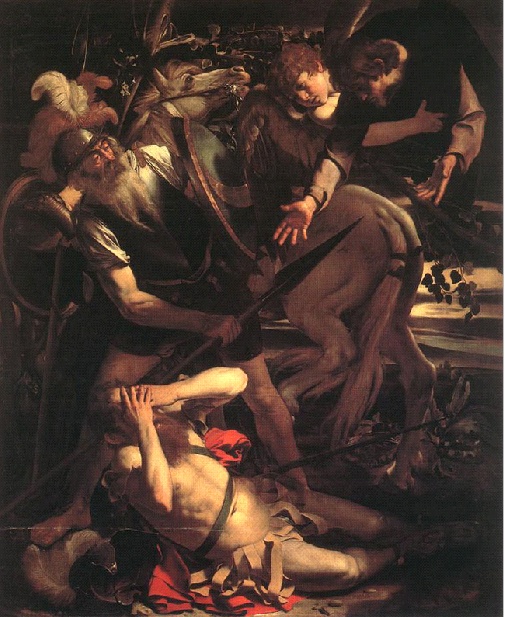
A very strange picture indeed. One is invited to look at Christ aided by a cherub imploring Saul to change his ways but only after the fact. It is the trajectory of the spear through the head at eye level that gets you there, a configuration that makes the painting awkward and unsuccessful. Is it the spear or the divine that is the cause of Saul’s ocular problem? At any rate, the divine is very much an afterthought. The second version, in the Cerasi Chapel, is just as radical if rather more minimalist, Hibbard rather irreverently catching the general gist of contemporary criticism—“one wag has likened it to an accident in a blacksmith’s shop” (Hibbard, 1983: 123)
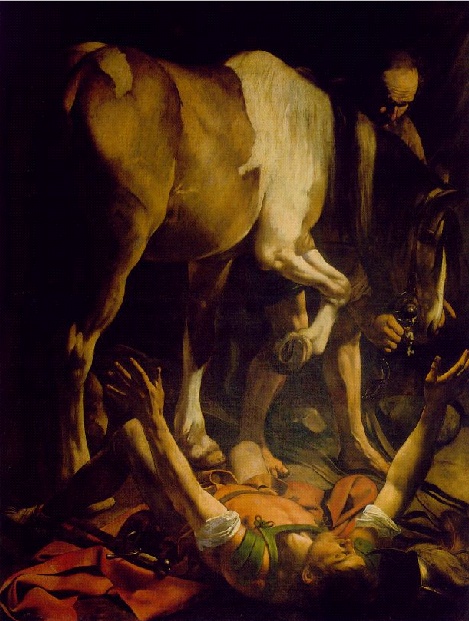
The most striking feature is of course Paul himself. But note now the complete absence of the divine. The veracity of Paul’s experience is contained within, an intuition confirmed by the crowded nature of the picture and the sense of confined space. However, the most important aspect of the picture is the eyes of Saul. They are closed, they are not receiving light, either natural or divine. There is some light but the divine seems curiously but definitively under-powered. Saul becomes Paul through a closed physiological process that is radically immanent – “it fits every type of mystical experience; mysticism perceives a body-own process as alien and originating ‘beyond’ one’s person, or beyond one’s earth” (Reich, 1945: 475). Paul also seems rather at peace, the closure of the eyes may bring a form of sanctuary, Caravaggio intuiting what modern psychology knows, that there are no recorded instances of full blindness and schizophrenia. A schizophrenic patient recounting her illness stated “The sunlight was dazzling and blinding – prolonged exposure was dangerous. I felt I had been subjected to an excess of light…the rape of the mind by truth (1955: 688). The non-importance of the divine, or its non-existence, might be regarded as further proof of Caravaggio’s naturalistic genius, the harbinger of psychological modernism in painting. But one literally “sees” an assault, on, or in, the eyes, with little concern for external causation. This accompanies the turn to violence noted by Hibbard earlier in 1599 with Judith. Reports of schizophrenics attacking their own eyes are quite commonplace in the medical literature (Jones, 1990; Brown et al, 1991) and attacks on the eyes of strangers while rare are not unknown (Mancinelli et al, 2004) and can achieve a definite notoriety as in the case of the murder of Jonathan Zito in London at the end of 1992. The first version reflects aggression towards the eyes and is typical of sharp instrument trauma to the eyes inflicted by paranoid schizophrenics (Hilal et al, 2006). The second version reflects the experience of the eyes themselves. It might be wondered if Caravaggio’s inspiration was his own physiological experience rather than a holy text and one might understand the disappointment of a proponent of the Counter-Reformation in relation to this work.
As Reich would have predicted, Caravaggio simultaneously turns his attention to the throat. One can see this in the two earlier paintings (1599) that made his reputation, his obsession with both parts of the body are there but in a much subtler and subdued form. Like the conversion of Saul, they are in accordance with scripture but reflect everyday life and experience. They are to be found in the Contarelli chapel, The Calling of St Matthew and The Martyrdom of St Matthew.
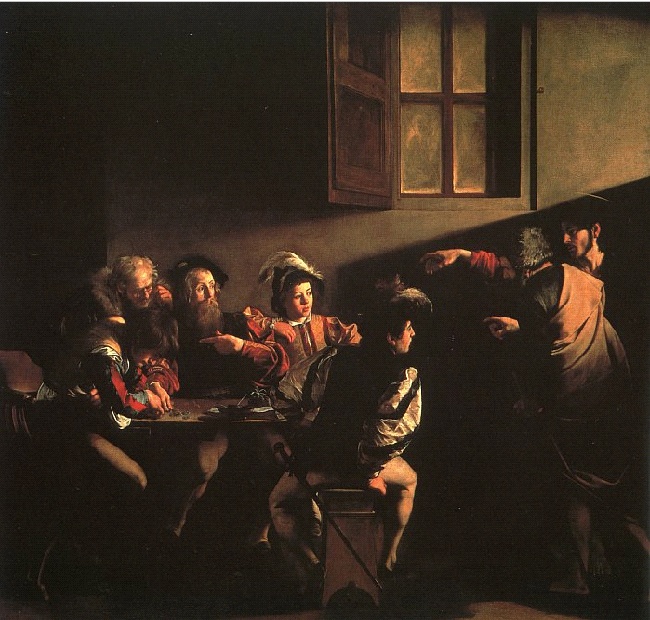
This painting is wonderfully understated. Christ and Peter (presumably) call Matthew to follow him and Christ’s limp hand points in Matthew’s direction, a hand certainly reminiscent of Michaelangelo’s creator-God. But, again the commentators have largely missed the significance of the work. The light that shines from right to left does not emanate from Christ, indeed its origin is completely unknown but nothing suggests other-worldly origin, quite the contrary. (ironically, it might be construed as resembling a TV set, a contemporary source of “command hallucinations in relation to light sources). Christ and Peter remain in the dark, indeed Hibbard describes their positioning as “perverse” and an “afterthought” (Hibbard, 1983:100). Matthew expresses his surprise, “Who me”? Or, “Why me”? The focus of the picture is once again ocular, the dual gaze of both Matthew and perhaps a young Caravaggio reflecting a rather dull and lifeless stare. Their looks do not reflect inspiration or excitation but a trance like stare. Matthew’s gaze and Christ’s do not meet. Matthew’s martyrdom is below.
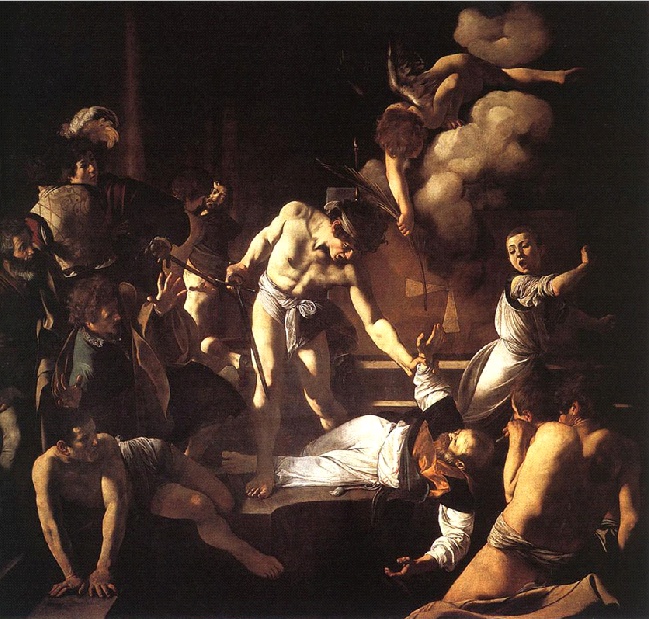
St Matthew is obviously here in deep trouble. He has already been wounded and is surely waiting the final coup-de-grace. His demise has been variously described as burning, stoning, peaceful death from old age in Palestine, or, beheading. After Judith and Medusa Caravaggio clearly decides to leave the ultimate point of arrival of the sword to the imagination of the viewer but there can be little doubt as to the imminent cause of death the above promises.
Clearly Caravaggio’s work does reflect an obsession with violence to the throat. Nothing really prepares his audience for the change around 1599. That impulse to violence would be directed outward at least in his art until the very end and his most celebrated artistic effort of all. However, Caravaggio’s art would predict a worsening of his behavior from 1599, sometimes held in check, but inexorably progressing to serious violence with substance abuse a strong contributing factor. Social and living conditions would also subsequently deteriorate. Judith does indicate a major psychotic episode that Caravaggio could barely keep in check even in the context of painting a conversion in a custom-house, and, as the comedian put it, “an accident in a Blacksmith’s shop”. The treatment of the eyes of both Matthew and Paul reflect Caravaggio’s alternating state between the socially withdrawn vacant stare of the schizophrenic and the intense and terrifying experience in the eyes described by Reich. Both are works of naturalistic genius that overthrow centuries of tradition, but that very naturalistic modesty in which their genius is said to consist may represent a holding strategy from a sick man representing, and reflecting upon, his own physical experience. The pictures of St Matthew in themselves are a case in point. The Calling can hardly be reckoned a masterpiece of narrative or technical composition – Matthew is called by a light emanating from where we know not, presumably initiated by a Christ whose gaze he does not meet. It is technically unappealing and unsuccessful in its use of perspective. The Martyrdom is the least revolutionary of Caravaggio’s major works. The figures are conventional if successful in conveying energetic panic. That conventionality might simply be due to the fact that the space to covered was twice the size of what he had done previously. The real action is confined to the two central figures and the forthcoming attack on the body. Caravaggio may simply have been psychologically unable to deal with that open space. The other three paintings reflect the claustrophobic constriction of space that Caravaggio felt in himself. And, perhaps, as Reich observed, in relation to paranoid schizophrenia, his eyes and his throat. It is no coincidence, that, at the same time, Caravaggio’s paintings become “night-like by 1600” (Hibbard, 1983: 259). The Matthew and Paul series represent Carvaggio’s own suffering rather than that of his saints. An objection might be placed that the level of violence in Caravaggio in general is in broad accord with the pictures of the day. It is also a fact that these are commissioned scenes of violence, and, common sense would dictate that a non-violent depiction of martyrdom might exceed any artist’s powers of presentation. These scenes are, in a sense, “overdetermined”. However, Caravaggio’s depiction of suffering is secular, brutally physical and not about the overcoming of fear and the embrace of death to the glory of God. Souls are not waiting to be borne to heaven by a host of angels and the community of saints. This is violence directed to discrete parts of the body. The religious and transcendent content is minimal, the very least that Caravaggio can get away with, or consciously subvert, a fact that his non-compliant patrons grasped with consummate ease. Much of the later and most extreme violence is non-commissioned in any case. Of course from now on heads will roll with monotonous regularity, with the artist representing and communicating violence to the throat on a regular basis. “More than a third of the paintings attributed to him depict scenes of violence with decapitation the clear favorite among them” (Varriano, 2006: 73). Sometimes it will be presented so very discreetly. Below is one of Caravaggio’s most famous paintings, the Beheading of St John the Baptist. The saint’s throat is already cut, the executioner now moving to decapitation. The artist signs his name in John’s blood. We would argue that this painting bears direct relation to the painting of Judith. Both make reference to one of the fundamental terrors of paranoid schizophrenia, the so-called “draining fantasy” (Karon & Rosberg, 1958). Schizophrenics make constant reference to being “emptied out” or “hollow” and the draining of bodily fluids is a continuing theme in regard to their somatic delusions. The latter’s characterization of these is rather fanciful but the projection of bodily processes, and experiencing them as foreign, is real enough. John is being drained.
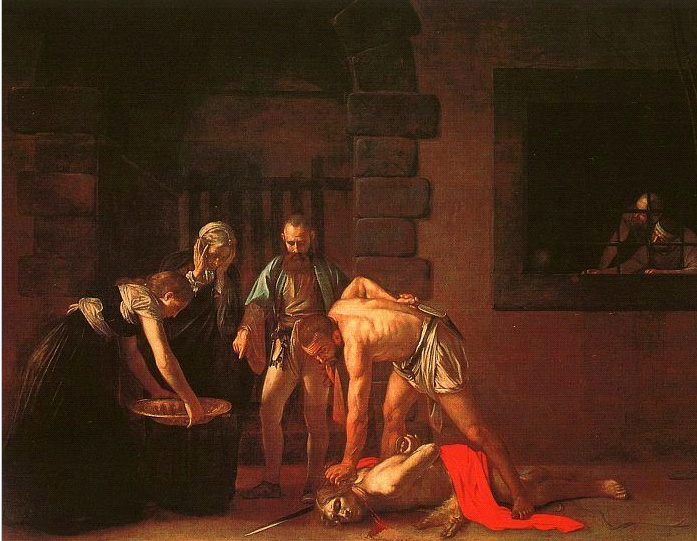
Caravaggio painted the Burial of St Lucy (1608) immediately after with the knife-wound to the throat of the female saint barely noticeable. That must have been difficult for the artist and there is clear physical evidence from X-rays that Caravaggio’s original depiction was a lot more brutal. The artist towards the end of his life can barely contain his predilection towards portraying sharp instrument trauma to the throat. This is reproduced below, the picture is badly damaged.
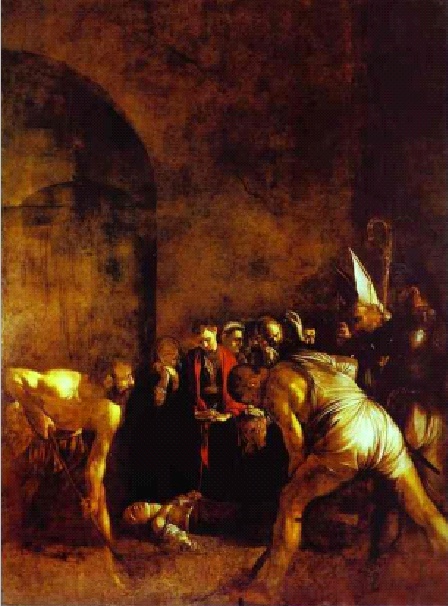
Decapitation after the fact is also prevalent even in the most genteel circumstances, for example, the skull in the pictures of St Jerome Writing and in St Francis in Meditation. Also, in more rigorous physical circumstances with Mary Magdalen in Ecstasy. Mary’s left elbow reposes upon a skull during the intense physical experience that once again suggests the Reichian analysis of schizophrenia as distorted perception of physiological process. These were painted immediately prior to, and after, the encounter with Tomassoni respectively. We are resistant to the idea that this represents the level of the symbolic. It is an attack on the real with the weapon of choice, the blade. In actual fact, there is little existent reliable literature on the nature and prevalence of sharp instrument trauma inflicted by paranoid schizophrenics in relation to others (apart from the most sensationalist accounts retrievable by a cursory internet search). Some authors have made an explicit link between schizophrenia of this sort and decapitation (Evans & Malesu, 2001) by means of knife or machete. The latter study concerned Barbados, but studies by Asuni (1969) in Nigeria, and Wong & Singer (1973), in relation to Hong Kong, does show cross-cultural similarities in relation to the kinds of wounds evident in the above. Indeed Cassell (1977) has demonstrated that the very presence of sharp objects and mention of anatomical parts of the body is sufficient to flood the mind of the schizophrenic with violent fantasies. The following is one of the most famous paintings in art, one of three versions of the story. The severed head is a self-portrait by Caravaggio himself. Legend has it that Caravaggio painted this in 1609-10 as a plea for a pardon in regard to the murder of Tomassoni so that he himself would not have to take the risk. But that this was his primary motivation is unlikely given his obsession with John, headed and beheaded. There is also compelling evidence to suggest that he began the painting the year after the murder itself (the National Gallery in London gives the dates 1606-10 but 1607 may be the best guess). This picture has probably been the source of a thousand comments on the fear of castration, usually from the psychoanalytic perspective, but it is a real fearful fantasy associated with schizophrenia (Martin & Gattaz,1991)
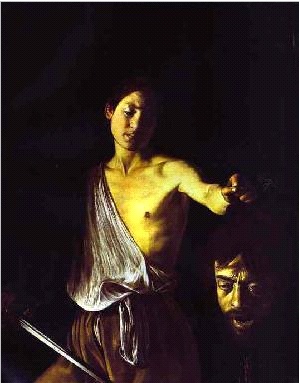
Clearly, Caravaggio has committed suicide, 10-13% of all schizophrenics do (Hunt et al, 2006). But he has seen the end coming for a long time and the terror of Judith has been replaced by the sort of empathy displayed by David – Caravaggio’s fundamental schizophrenic terror was decapitation – and there is clear evidence that this is still a fundamental terror of modern schizophrenics – “That hospitalization marked the first time I had ever admitted to anyone what was happening inside my head: for years I had witnessed my own decapitation” (Anonymous, 1992: 333). The problem is my head, rather than in my head, he seems to be suggesting to himself and David does have the look of a man who has gained a good deal of self-understanding. I can master my “annihilation anxiety” (Binder, 2006;Texeira, 1984). The conventional wisdom was that Caravaggio killed Tomassoni over a ten scudi bet on a tennis match. That is until S.Corradini and M. Marini (1993) suggested, quite convincingly, that Caravaggio probably killed Tomassoni when attempting to castrate him – the barber’s report from the Rome State Archives showed that the latter bled to death through the femoral artery. They have also speculated that this attack was over a prostitute, one Fillide Melandroni, and Tomassoni was her pimp. But Tomassoni also received wounds to the neck and head (close to the eyes it might be speculated). Caravaggio would inflict further serious injury before his death, from heat exhaustion chasing a boat along a shore in the heat of the Italian summer (itself indicative of a psychotic episode). But the above surely constitutes the epitome of self-understanding through art in the western tradition. Note the position of the sword right next to the genitalia, David is in real danger of doing himself some serious damage. The eyes of the severed head are those of a man who has seen too much, they speak of exhausted terror. The wounds to the neck of Tomassoni have been repaid with interest. Real terror comes only from within the body.
References
Anonymous (1992) “First Person Account: Portait of a Schizophrenic" Schizophrenia Bulletin 18,2 333-35
Anonymous (1955) “An autobiography of a schizophrenic experience” Journal of Abnormal and Social Psychology 51,3 677-89
Asuni, K (1969) “Homicide in Western Nigeria” British Journal of Psychiatry 115 1105-13
Binder, P (2006) “On the Verge of Unthinkable Anxiety” International Forum of Psychoanalysis 154, 201-11
Brown, R et al (1991) “Self-inflicted eye injuries” British Journal of Opthamology 75, 8 496-99
Casell, W (1977) “Aggressive imagery and clinical symptoms in Schizophrenia” British Journal of Projective Psychology and Personality Study 22,1 34-46
Corradini,S & Marini (1993), M Carravagio – materiali per un processo Rome: Alma
Chessick, M. (2000) “Saints and Sinners” American Journal of Psychiatry 157,12 2066-68
Dixon, L (1999) “Dual Diagnosis of Substance Abuse in Schizophrenia: Prevalence and Impact on Outcomes” Schizophrenia Research 35 93-110
DSM-IV-TR (2000) American Psychiatric Association
Evans, C & Malesu, R “Homicide in Barbados: an 18yr review” Journal of Forensic Psychiatry and Psychology 12,1 182-93Fried, M (1997) “Thoughts on Caravaggio” Critical Inquiry 24 13-56
Friedlander, W (1955) Caravaggio Studies New Jersey: Princeton University Press
Gilbert, C (1995) Caravaggio and his Two Cardinals
Hibbard, H (1983) Caravaggio New York: Harper & Row
Hilal, A et al (2006) “An act of homicide and what it brings to mind” Legal Medicine 8,5 293-96
Hunt, I et al (2006) “Suicide in Schizophrenia: Findings from a National Clinical Study” Journal of Psychiatric Practice 12,3 40-52
Jayal et al, C (2007) “Major Mental Disorders and Violence: A Critical Update” Current Psychiatry Reviews 3,1 33-50
Karon, B & Rosberg J (1958) “The Homosexual Urges in Schizophrenia” Psychoanalysis and Psychoanalytic Review 40, 50-56
Jones, N (1990) “Self-Enucleation and Psychosis” British Journal of Opthamology 74, 9 571-74
Langdon, S (1999) Caravaggio: A Life New York: Farrar, Straus & Giroux
Mancinelli, I (2004) “Enucleation in Psychosis associated with acqueductal stenosis” Journal of Forensic Science 49, 2 361-63
Martin, T & Gattaz, W (1991) “Psychiatric Aspects of Male Genital Self-Multilation” Psychopathology 24,3 170-78
Poseq, A (1990) “Caravggio’s Self-Portrait as the Beheaded Goliath” Konsthistorisk Tidskrift 59 169-82
Reich, W (1945) Character Analysis trans. V. Carfagno New York: Farrar, Straus & Giroux
Schanda, H et al (2004) “Homicide and Major Mental Disorders: a 25 Year Study” Acta Psychiatrica Scandanavia 110,2 98-107
Selton, J.P. (2007) “Migration and Schizophrenia” Current Opinion in Psychiatry 20,2 11-15
Teixeira (1984) “Annihilation anxiety in Schizophrenia: Metaphor or Dynamic?”Psychotherapy, Theory, Research, Practice, Training 21, 3 377-81
Tilman, S, et al, “Violence and Schizophrenia: Two Types of Criminal Behavior” European Journal of Psychiatry 12,3 153-65
Torrey, E (2006) “Violence and Schizophrenia” Schizophrenia Research 88, 1-3, 3-4
Valenstein, M et al (2004) “Poor antipsychotic adeherence amaong patients with schizophrenia” Schizophrenia Bulletin 30, 255-64
Varriano, J. (2006) Caravaggio: The Art of Realism University Park, Penn. State University Press
Wong, M & Singer, K (1973) “Abnormal Homicide in Hong Kong” British Journal of Psychiatry 123 295-98
Received: January 1, 2007, Published: December 5, 2007. Copyright © 2007 Ronnie Mather
